| Rubber Bug Collecting: Coleoptera |
Coleoptera, the beetles, make up not only the majority of insect life but the single largest
group of animals on the planet Earth. They are characterized by a complete metamorphosis
(a life cycle that includes a larval and pupal stage) and the foremost pair of wings modified
into a tough shell that closes tightly over the second pair. Some species are, however,
adapted to a completely wingless form.
group of animals on the planet Earth. They are characterized by a complete metamorphosis
(a life cycle that includes a larval and pupal stage) and the foremost pair of wings modified
into a tough shell that closes tightly over the second pair. Some species are, however,
adapted to a completely wingless form.
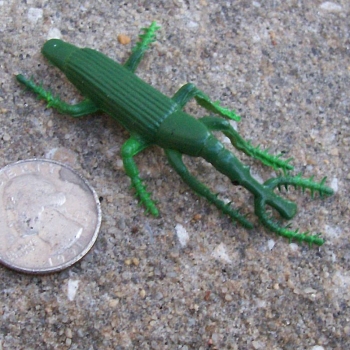
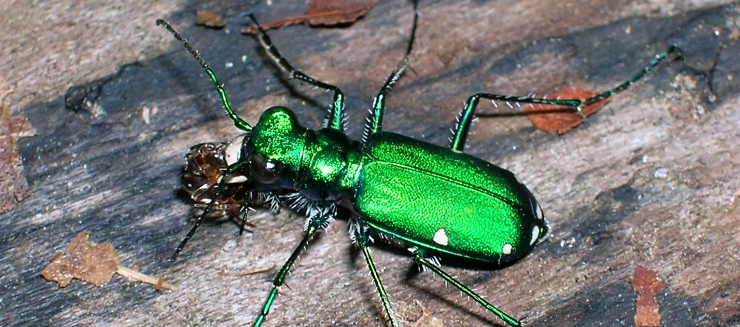
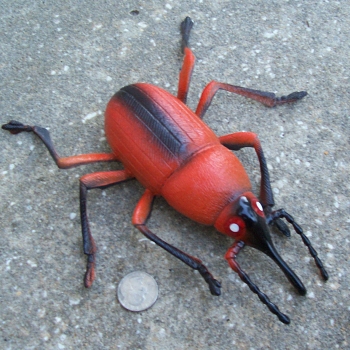
This small weevil is a very common mold in
rubber-bug variety bags. Though small and
seldom noticed, weevils comprise the largest
superfamily within the Coleoptera, representing
an estimated 10% of all animal species.
rubber-bug variety bags. Though small and
seldom noticed, weevils comprise the largest
superfamily within the Coleoptera, representing
an estimated 10% of all animal species.
One of my all-time favorite bug toys, these big
weevils come in many variants. I've even found
one with a keyboard brush for a snout, sold as a
"computer bug." A weevil's snout is tipped with a
tiny set of jaws, ideal for drilling into plant life.
weevils come in many variants. I've even found
one with a keyboard brush for a snout, sold as a
"computer bug." A weevil's snout is tipped with a
tiny set of jaws, ideal for drilling into plant life.
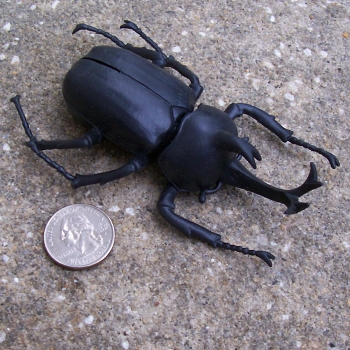
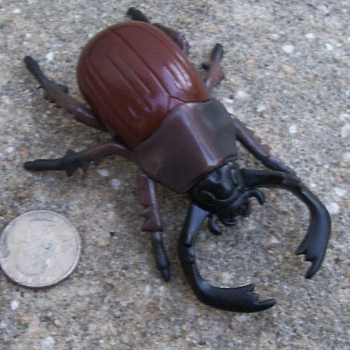
This amazingly life-like (and roughly life-sized!)
elephant beetle was found at dollar tree and
filled with liquid candy. This is one of the species
raised for fighting in Japan, a hobby that
inspired Pokemon.
elephant beetle was found at dollar tree and
filled with liquid candy. This is one of the species
raised for fighting in Japan, a hobby that
inspired Pokemon.
Another candy-filled beetle, this is a fictional
species superficially resembling a stag beetle.
species superficially resembling a stag beetle.
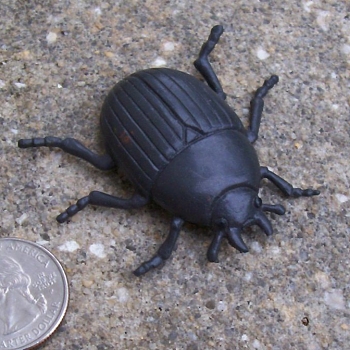
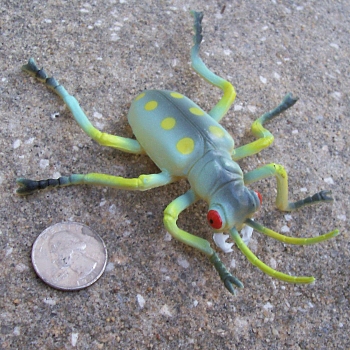
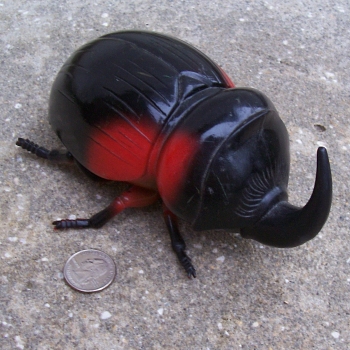
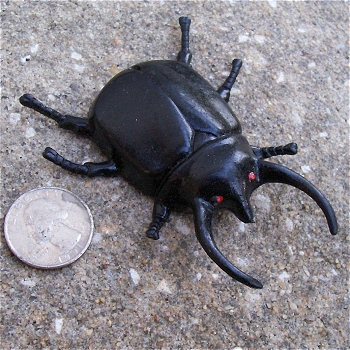
This horned beetle is not only an exceptionally
large, fat bug toy, but made from the hardest
plastic of any I own. You could really hurt
someone with this thing.
large, fat bug toy, but made from the hardest
plastic of any I own. You could really hurt
someone with this thing.
This nondescript, rather pathetic-looking beetle
came attached to a pump (like one of the toys in
the spider page) that made the toy hop around
when squeezed.
came attached to a pump (like one of the toys in
the spider page) that made the toy hop around
when squeezed.
This otherwise nondescript-looking insect is in
fact a very specific animal, a hister beetle. Able
to withdraw their appendages in a turtle-like
fashion, these well-armored insects fly to carrion
or dung where they prey upon maggots or other
insect larva. Certain mites that prey on fly's eggs
even use these beetles as transportation,
clinging to the Hister's legs or backside.
fact a very specific animal, a hister beetle. Able
to withdraw their appendages in a turtle-like
fashion, these well-armored insects fly to carrion
or dung where they prey upon maggots or other
insect larva. Certain mites that prey on fly's eggs
even use these beetles as transportation,
clinging to the Hister's legs or backside.
A tiger beetle (see photograph at top of page) is
rarely seen in toy form. These colorful
carnivores run incredibly fast as adults, but the
larval stage is a patient ambush predator,
concealing itself in a burrow and springing out
as tasty insects wander too close.
rarely seen in toy form. These colorful
carnivores run incredibly fast as adults, but the
larval stage is a patient ambush predator,
concealing itself in a burrow and springing out
as tasty insects wander too close.
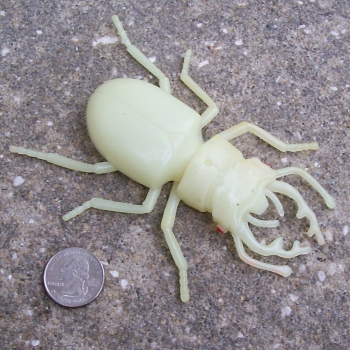
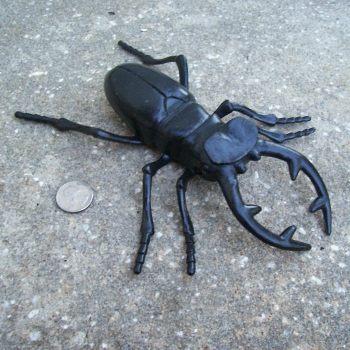
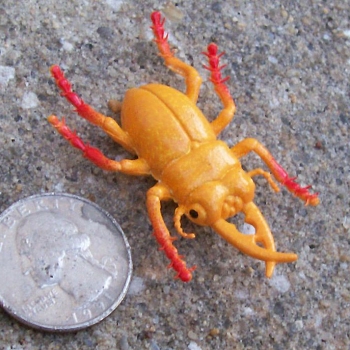
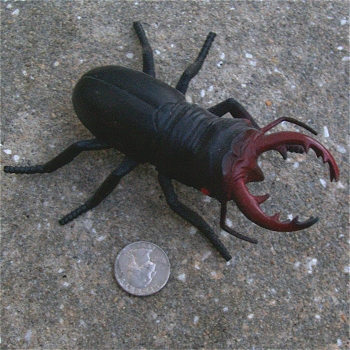
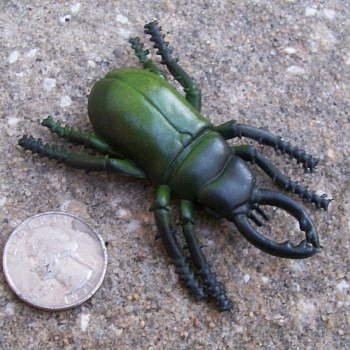
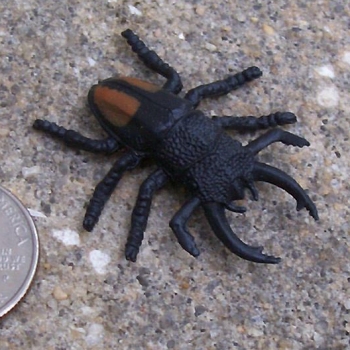
Stag Beetles seem to the most iconic beetle after the ladybug, and possibly one of the most
iconic insects. I've seen toys of this insect in dozens of shapes and sized besides these. My
favorite is probably the fourth one here, I'm not sure why.
Another popular insect in Japanese beetle-fighting, only the male stag beetles bear the
famous antler-like mandibles, which they use to wrestle one another over access to females.
iconic insects. I've seen toys of this insect in dozens of shapes and sized besides these. My
favorite is probably the fourth one here, I'm not sure why.
Another popular insect in Japanese beetle-fighting, only the male stag beetles bear the
famous antler-like mandibles, which they use to wrestle one another over access to females.
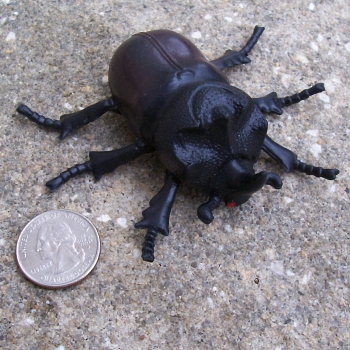
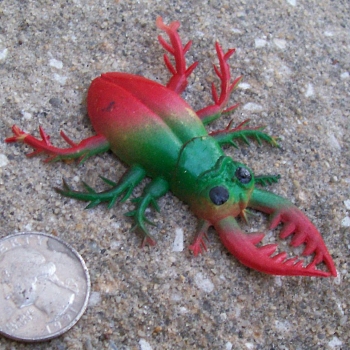
I've seen rhinoceros beetles identical to this
one in several different sizes. Part of the scarab
family, these include some of the world's largest
beetles and the world's strongest animals, able
to lift over 800 times their own weight.
one in several different sizes. Part of the scarab
family, these include some of the world's largest
beetles and the world's strongest animals, able
to lift over 800 times their own weight.
This was clearly intended to be a stag beetle, but
it isn't even an insect - notice the extra legs.
These horrible arachno-beetles probably herald
the end of mankind.
it isn't even an insect - notice the extra legs.
These horrible arachno-beetles probably herald
the end of mankind.
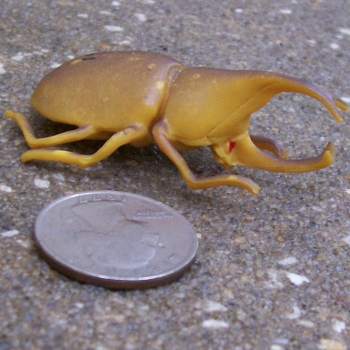
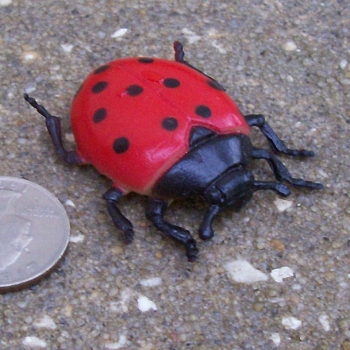
Known to the west as a "ladybug," but more
properly a ladybird beetle or just ladybird, it's
odd that these acid-puking predators are often
the one insect that bug-haters make any
exception for. Show them a beetle in a different
shape or different color, and the simpletons are
repulsed.
properly a ladybird beetle or just ladybird, it's
odd that these acid-puking predators are often
the one insect that bug-haters make any
exception for. Show them a beetle in a different
shape or different color, and the simpletons are
repulsed.
A cool little elephant beetle, this is made of
tough plastic and actually came inside of a
transparent bar of soap.
tough plastic and actually came inside of a
transparent bar of soap.
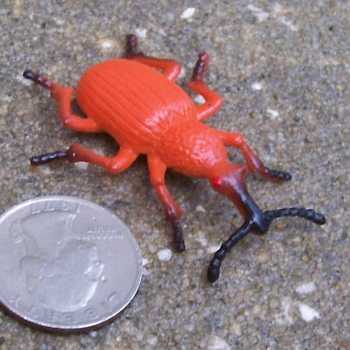
Another, very nice-looking weevil. I've seen this
in several colors but this brilliant orange-red
with dark extremities is the coolest looking.
in several colors but this brilliant orange-red
with dark extremities is the coolest looking.
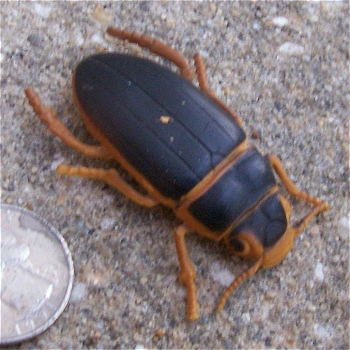
Perhaps not that exciting to look at, but this is
the one of the few toys I have of an aquatic
insect. Diving beetles breathe air through the tip
of the abdomen, which bears special bristles for
trapping and carrying a bubble of air.
the one of the few toys I have of an aquatic
insect. Diving beetles breathe air through the tip
of the abdomen, which bears special bristles for
trapping and carrying a bubble of air.